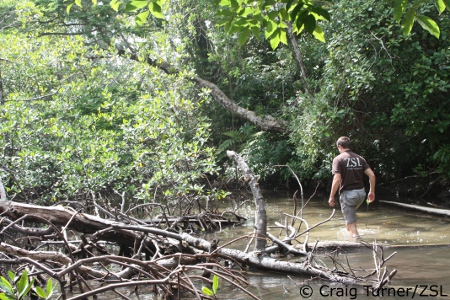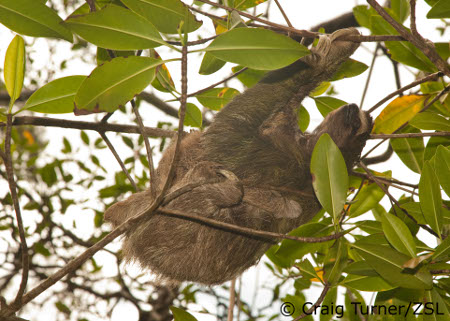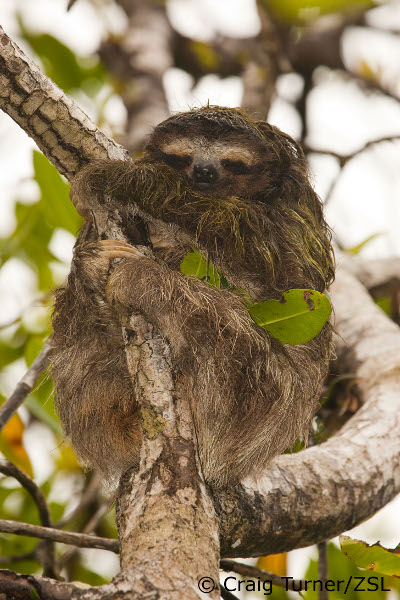Our two EDGE scientists David and Craig had battled bad weather and stormy seas to get a glimpse of the elusive pygmy three-toed sloth on Escudo Island. They had managed to spot one shy female hidden in the mangroves, but they held out hope to find more…
We woke up to discover that the cloud had cleared and the sun was once again struggling to burst through. Gustavo laid out a sumptuous breakfast feast which we rapidly devoured whilst Sebastian readied the boat for the day ahead. The plan was to spend the first three days mapping all of the known mangrove patches on the island. This would give us an understanding of just how much mangrove habitat was available for the sloths to live in. It turned out that this task would prove to be much harder than was first thought.
That morning we headed straight to the site where we had seen our first sloth on the previous day. The site was a relatively small lagoon (less than two hectares) fringed with red mangrove trees. Their characteristic roots formed a dense maze which proved to be difficult to negotiate. The water was brown and murky and suddenly the idea of wading through it seemed less appealing. This was compounded by the heavens opening and the rain lashed down once again.
Craig took the plunge and jumped straight in, anticipating the water to be only a few inches deep but much to his surprise he found himself immersed up to the chest. I thought I would learn from his mistake and instead weaved a path to an area of high ground via the natural bridges created by the roots. However, it seemed that this wasn’t meant to be and as the third root snapped like a twig and I went head first into the water. It was a good job we had those dry-bags!
Sebastian roared with laughter to see the pair of us struggling in the mud but caught his breath to warn us about the threat of crocodiles. “!@*$?!” was our simultaneous response. “I’m only messing with you guys” he laughed, “I’ve never seen any crocodiles here”. We left Sebastian giggling to himself in the boat and set off along the periphery of the forest, logging our position with our GPS unit every 5 metres or so and spotting the occasional sloth in the canopy. We managed to map two mangrove patches that morning with every step placed with the utmost care for fear of disturbing what lurked beneath.

That afternoon we set off to the other side of the island and found several more patches of mangroves. Some were of a similar nature to the first – deep, dark and muddy – but there were a couple which were more exposed to the force of the waves. These patches had sandy bottoms and we had the luxury of seeing where we were placing our feet. However, this did not mean that we got complacent. Every other step we would find ourselves knee deep in the soft sediment and would require the help of the other to free our boots. There were also occasions where the soil would seem to part and within a split second one, if not both, of us would be stuck in the mud up to our chests.
Needless to say, our progress was slow and every evening we got into the regular routine of cleaning out our scrapes and wounds, dosing them with iodine and bandaging them up ready to go again the next morning. My right shin has never quite recovered but after four days we eventually managed to map all of the 14 known mangrove areas on Escudo Island.
The next stage of the survey was to actually count the sloths. This meant more wading through the mangroves as we had to run line transects through the forest. Unfortunately ‘through’ the forest meant negotiating all those roots which in turn resulted in more gashes on our shins. On one transect, Craig and I were approaching the end when we noticed a sloth sitting very low down in a tree – it was less than two metres off the ground so we logged its location and decided to investigate more closely.
As we approached it remained calm and undisturbed. I stepped up onto one of the roots for a better view and to my complete surprise I saw not only one face, but two! A baby was clinging to its mother’s big belly as tight as it could and had it not been for its small dark face I would have thought it was just an incredibly fat sloth. This was great news because we now knew the population was definitely breeding. We ended up seeing another six mothers holding juveniles, although we think that a few of the sightings may have been of the same individual.

Over the next five days, Craig and I completed over 70 transects through the forest (in between the odd bat survey during the evenings), but encountered fewer than 40 sloths. Although we couldn’t have possibly seen every one, it seemed likely that the population of the species is much lower than we had originally expected. We are currently in the process of writing up our data and hope to publish it later this year.

We presented our initial findings and discussed how to move the project forward based on the new information we had gathered. We are now hoping to fund a young Panamanian conservationist under the EDGE of Existence Fellows programme who will work with the local community to help protect this species before it is too late.
Until the end of July we are running a campaign to raise £5,000 for pygmy sloth conservation, so please help us save this unique animal by donating today.
You can also read more about the expedition and the project in our articles in the upcoming editions of ZSL’s Wild About magazine and the bulletin of the British Ecological Society.